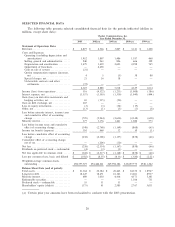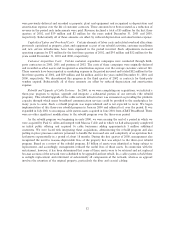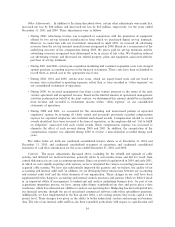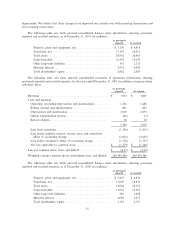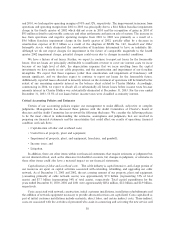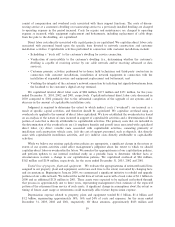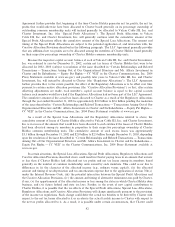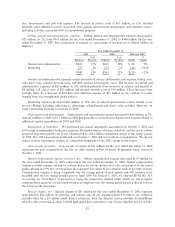Charter 2003 Annual Report Download - page 40
Download and view the complete annual report
Please find page 40 of the 2003 Charter annual report below. You can navigate through the pages in the report by either clicking on the pages listed below, or by using the keyword search tool below to find specific information within the annual report.and 2001, we had negative operating margins of 95% and 32%, respectively. The improvement in income from
operations and operating margin from 2002 to 2003 was principally due to a $4.6 billion franchise impairment
charge in the fourth quarter of 2002 which did not recur in 2003 and the recognition of gains in 2003 of
$93 million related to unfavorable contracts and other settlements and gain on sale of system. The increase in
loss from operations and negative operating margins from 2001 to 2002 was primarily as a result of a
$4.6 billion franchise impairment charge in the fourth quarter of 2002, partially oÅset by a decrease in
amortization expense of $1.5 billion as a result of the adoption of SFAS No. 142, Goodwill and Other
Intangible Assets, which eliminated the amortization of franchises determined to have an indeÑnite life.
Although we do not expect charges for impairment in the future of comparable magnitude to the fourth
quarter 2002 impairment charge, potential charges could occur due to changes in market conditions.
We have a history of net losses. Further, we expect to continue to report net losses for the foreseeable
future. Our net losses are principally attributable to insuÇcient revenue to cover our interest costs we incur
because of our high level of debt, the depreciation expenses that we incur resulting from the capital
investments we have made in our cable properties, and the amortization and impairment of our franchise
intangibles. We expect that these expenses (other than amortization and impairment of franchises) will
remain signiÑcant, and we therefore expect to continue to report net losses for the foreseeable future.
Additionally, reported losses allocated to minority interest on the statement of operations will be limited to the
extent of any remaining minority interest on the balance sheet related to Charter Holdco. Accordingly,
commencing in 2004, we expect to absorb all, or substantially all, future losses before income taxes because
minority interest in Charter Holdco was substantially eliminated at December 31, 2003. For the year ended
December 31, 2003, 53.5% of our losses before income taxes were classiÑed as minority interest.
Critical Accounting Policies and Estimates
Certain of our accounting policies require our management to make diÇcult, subjective or complex
judgments. Management has discussed these policies with the Audit Committee of Charter's board of
directors and the Audit Committee has reviewed the following disclosure. We consider the following policies
to be the most critical in understanding the estimates, assumptions and judgments that are involved in
preparing our Ñnancial statements and the uncertainties that could aÅect our results of operations, Ñnancial
condition and cash Öows:
‚ Capitalization of labor and overhead costs;
‚ Useful lives of property, plant and equipment;
‚ Impairment of property, plant, and equipment, franchises, and goodwill;
‚ Income taxes; and
‚ Litigation.
In addition, there are other items within our Ñnancial statements that require estimates or judgment but
are not deemed critical, such as the allowance for doubtful accounts, but changes in judgment, or estimates in
these other items could also have a material impact on our Ñnancial statements.
Capitalization of labor and overhead costs. The cable industry is capital intensive, and a large portion of
our resources are spent on capital activities associated with extending, rebuilding, and upgrading our cable
network. As of December 31, 2003 and 2002, the net carrying amount of our property, plant and equipment
(consisting primarily of cable network assets) was approximately $7.0 billion (representing 33% of total
assets) and $7.7 billion (representing 34% of total assets), respectively. Total capital expenditures for the
years ended December 31, 2003, 2002 and 2001 were approximately $854 million, $2.2 billion and $2.9 billion,
respectively.
Costs associated with network construction, initial customer installations, installation refurbishments and
the addition of network equipment necessary to provide advanced services are capitalized. Costs capitalized as
part of initial customer installations include materials, direct labor, and certain indirect costs. These indirect
costs are associated with the activities of personnel who assist in connecting and activating the new service and
38


